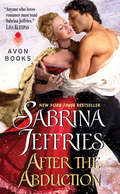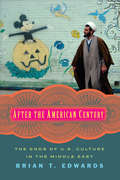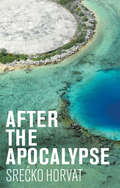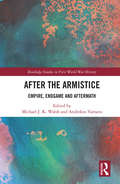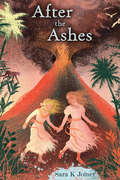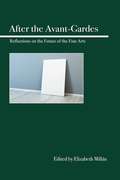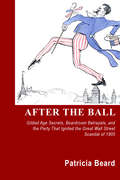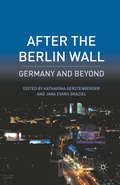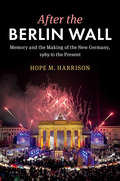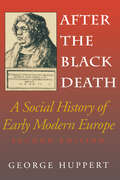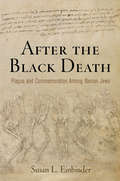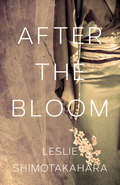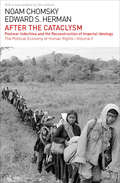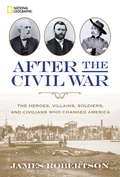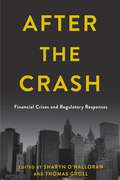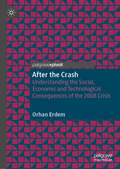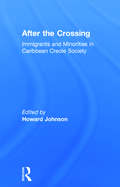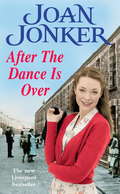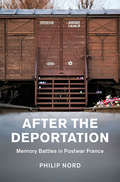- Table View
- List View
After the Abduction
by Sabrina JeffriesAfter two London seasons--and a score of resoundingly dull society suitors--Juliet Laverick finds herself longing for one man: Morgan Pryce, the dashing scoundrel who kidnapped her two years ago. But her determination to bring the rogue to justice hasn't waned--until Morgan's twin brother, Sebastian, arrives with some shocking news: Juliet's mysterious paramour has disappeared.Sebastian, Lord Templemore, dares not tell Juliet the truth: he is the man she seeks--it is his kiss she yearns for. Confessing to the abduction would bring devastating scandal upon them both. But how can he persuade her to forsake her dedicated pursuit of her dream lover, when all he dreams of is holding her in his arms again?
After the American Century: The Ends of U.S. Culture in the Middle East
by Brian EdwardsWhen Henry Luce announced in 1941 that we were living in the "American century," he believed that the international popularity of American culture made the world favorable to U.S. interests. Now, in the digital twenty-first century, the American century has been superseded, as American movies, music, and video games are received, understood, and transformed. <P><P>How do we make sense of this shift? Building on a decade of fieldwork in Cairo, Casablanca, and Tehran, Brian T. Edwards maps new routes of cultural exchange that are innovative, accelerated, and full of diversions. Shaped by the digital revolution, these paths are entwined with the growing fragility of American "soft" power. They indicate an era after the American century, in which popular American products and phenomena—such as comic books, teen romances, social-networking sites, and ways of expressing sexuality—are stripped of their associations with the United States and recast in very different forms. Arguing against those who talk about a world in which American culture is merely replicated or appropriated, Edwards focuses on creative moments of uptake, in which Arabs and Iranians make something unexpected. He argues that these products do more than extend the reach of the original. They reflect a world in which culture endlessly circulates and gathers new meanings.
After the Apocalypse
by Srećko HorvatIn this post-apocalyptic rollercoaster ride, philosopher Srećko Horvat invites us to explore the Apocalypse in terms of ‘revelation’ (rather than as the ‘end’ itself). He argues that the only way to prevent the end – i.e., extinction – is to engage in a close reading of various interconnected threats, such as climate crisis, the nuclear age and the ongoing pandemic. Drawing on the work of neglected philosopher Günther Anders, this book outlines a philosophical approach to deal with what Horvat, borrowing a term from climate science and giving it a theological twist, calls ‘eschatological tipping points’. These are no longer just the nuclear age or climate crisis, but their collision, conjoined with various other major threats – not only pandemics, but also the viruses of capitalism and fascism. In his investigation of the future of places such as Chernobyl, the Mediterranean and the Marshall Islands, as well as many others affected by COVID-19, Horvat contends that the ‘revelation’ appears simple and unprecedented: the alternatives are no longer socialism or barbarism – our only alternatives today are a radical reinvention of the world, or mass extinction. After the Apocalypse is an urgent call not only to mourn tomorrow’s dead today but to struggle for our future while we can.
After the Armistice: Empire, Endgame and Aftermath (Routledge Studies in First World War History)
by Michael J. K. Walsh; Andrekos VarnavaA century after the Armistice and the associated peace agreements that formally ended the Great War, many issues pertaining to the UK and its empire are yet to be satisfactorily resolved. Accordingly, this volume presents a multi-disciplinary approach to better understanding the post-Armistice Empire across a broad spectrum of disciplines, geographies and chronologies. Through the lens of diplomatic, social, cultural, historical and economic analysis, the chapters engage with the histories of Lagos and Tonga, Cyprus and China, as well as more obvious geographies of empire such as Ireland, India and Australia. Though globally diverse, and encompassing much of the post-Armistice century, the studies are nevertheless united by three common themes: the interrogation of that transitionary ‘moment’ after the Armistice that lingered well beyond the final Treaty of Lausanne in 1924; the utilisation of new research methods and avenues of enquiry to compliment extant debates concerning the legacies of colonialism and nationalism; and the common leitmotif of the British Empire in all its political and cultural complexity. The centenary of the Armistice offers a timely occasion on which to present these studies.
After the Ashes
by Sara K. JoinerIn 1883, on the island of Java in the Dutch East Indies, thirteen-year-old Katrien Courtland is determined to prove Darwin's theory of natural selection. Unfortunately, nothing causes her Aunt Greet more angst than Katrien crawling around the muddy jungle collecting bugs in the name of science -- and in the company of a native boy, no less! If only Katrien would take an interest in running a household and making friends with other girls. But Katrien has no interest in changing, especially if it means socializing with the likes of mean Brigitta Burkhart. Then, one stifling afternoon, Katrien's world turns upside-down when the nearby volcano Krakatau erupts with a terrifying blast. For days, a deathly ash rains down on the Javan coast. Amidst the chaos, Katrien knows her only hope of survival is to flee the jungle with the one person she vowed she'd never befriend.
After the Avant-Gardes
by Elizabeth MillánA rallying call for all those who have been disquieted or disgusted by the excesses of artistic modernism. This is a collection of ten provocative essays on the arts, by writers of varied orientations who share a skepticism about the exaggerated role of modernism and the successive avant-gardes in shaping what is accepted as valid contemporary art. The essays cover painting and other visual arts, literature, music, and general observations about all the arts. It is not an exercise in hand-wringing about the current state of the arts, but looks for different directions in which the arts may now fruitfully evolve. Despite the diverse philosophies of the contributors, these essays together constitute a formidable case against the unhealthy impact of avant-gardism on our lives and aesthetic culture. The essays include the following, among others: a study of anti-modernist painter Odd Nerdrum, who sees modernist art as totalitarian; a critique of the avant-gardist neglect of mimesis as a key to art; an evaluation of "the end of art"; a critique of modern art in light of "the aesthetic harm principle"; an examination of Popper's objections to progressivism in music; the presentation of a new paradigm for literature.
After the Ball
by Patricia BeardAfter the Ball is that rare true story that reads like an epic novel, a sweeping chronicle of an era, and an intimate account of the hope and betrayal of a son whose father gave him everything--except the training to find his way in territory ruled by the rapacious.James Hazen Hyde was twenty-three in 1899 when he inherited the majority shares in the billion-dollar Equitable Life Assurance Society. Only five years later, he fell from grace in a Wall Street scandal that obsessed the nation and commanded 115 front-page articles in the New York Times.Hyde was intelligent, cultured, and ambitious, but he was no match for an older generation that had mapped the backstreets of high finance. Vying to control the Equitable's vast investment pool, the most famous financiers and industrialists of the era--among them E.H. Harriman, Henry Clay Frick, and J.P. Morgan--put Hyde on forty-eight boards and included him in deals that shook Wall Street. And then, at the pinnacle of social success, he made a fatal miscalculation.On the last night of January 1905, James Hyde held a fabulously flamboyant, eighteenth-century Versailles-themed costume ball. His enemies used the party as the hook to hang him on, claiming that he was too frivolous to run a company dedicated to protecting widows and orphans; and spread the rumor that he had spent two hundred thousand dollars to Equitable money on a night's entertainment. By the time a government investigation established that Hyde had paid the bills himself, his reputation was ruined.The bitter campaign to wrest control of the Equitable and its vast investment capacity from Hyde followed on the heels of the ball. As the fight escalated, clandestine alliance between insurers and Wall Street burst to the surface, exposing techniques that are the stuff of twenty-first-century scandals: self-dealing, insider trading, accounting malpractice, and corporate funding of private pleasure.After the Ball tells a tale that riveted millions of Americans a century ago. Its themes are as fresh today as they were in 1905: greed and chicanery, the flawed love between fathers and sons, and contradictory American attitudes about wealth--all unfolding against a setting of magnificence, excess, and corrupting glamour.Patricia Beard is the author of nine nonfiction books, one novel and hundreds of nationally published magazine articles. She has been an editor at Elle, Town & Country, and Mirabella magazines.An absorbing book about the financial scandal that consumed New York and the nation a century ago, AFTER THE BALL evokes a time of glamorous carelessness in life, love, and high finance.--Arthur M. Schlesinger, Jr. Pulitzer Prize Winning author and historianPatricia Beard's glittering...social history proves that "Plus ça change, plus c'est la même chose." The hubris, extravagance, greed, and social ambitions of the 1990s are perfectly mirrored in this tale of the early 1900s, which reads like a novel...Great fun, but with a sting in the tail--Michael Korda, author of Ike, An American HeroSuperbly researched and suspenseful...a tale of jealousy, greed, and conflicts of interest...reminds us that America's business scandals of the early twenty-first century are hardly unprecedented.--Richard H. Jenrette,Equitable Lie Assurance Society 1987-1996
After the Berlin Wall: Germany and Beyond
by Beyond GermanyTwenty years after its fall, the wall that divided Berlin and Germany presents a conceptual paradox: on one hand, Germans have sought to erase it completely; on the other, it haunts the imagination in complex and often surprising ways
After the Berlin Wall: Memory and the Making of the New Germany, 1989 to the Present
by Hope M. HarrisonThe history and meaning of the Berlin Wall remain controversial, even three decades after its fall. Drawing on an extensive range of archival sources and interviews, this book profiles key memory activists who have fought to commemorate the history of the Berlin Wall and examines their role in the creation of a new German national narrative. With victims, perpetrators and heroes, the Berlin Wall has joined the Holocaust as an essential part of German collective memory. Key Wall anniversaries have become signposts marking German views of the past, its relevance to the present, and the complicated project of defining German national identity. Considering multiple German approaches to remembering the Wall via memorials, trials, public ceremonies, films, and music, this revelatory work also traces how global memory of the Wall has impacted German memory policy. It depicts the power and fragility of state-backed memory projects, and the potential of such projects to reconcile or divide.
After the Berlin Wall: Putting Two Germanys Back Together Again
by Christopher HiltonOn 7 May 1945, Grand Admiral Donitz, named in Hitler's will as head of state, authorised the unconditional surrender of all German forces to the Allies on the following day. World War II in Europe was at an end. But many of the German people would continue to endure hardships, as both the country and the capital were to be divided between France, the UK and the USA in the west and the USSR in the east. East and West Germany, and East and West Berlin, would remain divided until 1989. By October 1990, however, the two countries were reunited, and the Berlin Reichstag was once again the seat of government. Here, politicians would put East and West back together again, marrying a totalitarian, atheist, communist system with a democratic, Christian, capitalist one. How did this marriage affect the everyday life of ordinary Germans? How did combining two telephone systems, two postal services, hospitals, farm land, property, industry, railways and roads work? How were women's rights, welfare, pensions, trades unions, arts, rents and housing affected? There had been no warning of this marriage and no preparation for it - and no country had ever tried putting two completely opposite systems together before. This is the story of what happened, in the words of the people it happened to - the people's story of an incredible unification.
After the Black Death, Second Edition: A Social History of Early Modern Europe
by George HuppertPraise for the first edition:"To give a sense of immediacy and vividness to the long period in such a short space is a major achievement." —History"Huppert's book is a little masterpiece every teacher should welcome." —Renaissance QuarterlyA work of genuine social history, After the Black Death leads the reader into the real villages and cities of European society. For this second edition, George Huppert has added a new chapter on the incessant warfare of the age and thoroughly updated the bibliographical essay.
After the Black Death: Plague and Commemoration Among Iberian Jews (The Middle Ages Series)
by Susan L. EinbinderThe Black Death of 1348-50 devastated Europe. With mortality estimates ranging from thirty to sixty percent of the population, it was arguably the most significant event of the fourteenth century. Nonetheless, its force varied across the continent, and so did the ways people responded to it. Surprisingly, there is little Jewish writing extant that directly addresses the impact of the plague, or even of the violence that sometimes accompanied it. This absence is particularly notable for Provence and the Iberian Peninsula, despite rich sources on Jewish life throughout the century.In After the Black Death, Susan L. Einbinder uncovers Jewish responses to plague and violence in fourteenth-century Provence and Iberia. Einbinder's original research reveals a wide, heterogeneous series of Jewish literary responses to the plague, including Sephardic liturgical poetry; a medical tractate written by the Jewish physician Abraham Caslari; epitaphs inscribed on the tombstones of twenty-eight Jewish plague victims once buried in Toledo; and a heretofore unstudied liturgical lament written by Moses Nathan, a survivor of an anti-Jewish massacre that occurred in Tàrrega, Catalonia, in 1348.Through elegant translations and masterful readings, After the Black Death exposes the great diversity in Jewish experiences of the plague, shaped as they were by convention, geography, epidemiology, and politics. Most critically, Einbinder traces the continuity of faith, language, and meaning through the years of the plague and its aftermath. Both before and after the Black Death, Jewish texts that deal with tragedy privilege the communal over the personal and affirm resilience over victimhood. Combined with archival and archaeological testimony, these texts ask us to think deeply about the men and women, sometimes perpetrators as well as victims, who confronted the Black Death. As devastating as the Black Death was, it did not shatter the modes of expression and explanation of those who survived it—a discovery that challenges the applicability of modern trauma theory to the medieval context.
After the Bloom
by Leslie ShimotakaharaA daughter’s search for her mother reveals her family’s past in a Japanese internment camp during the Second World War. Lily Takemitsu goes missing from her home in Toronto one luminous summer morning in the mid-1980s. Her daughter, Rita, knows her mother has a history of dissociation and memory problems, which have led her to wander off before. But never has she stayed away so long. Unconvinced the police are taking the case seriously, Rita begins to carry out her own investigation. In the course of searching for her mom, she is forced to confront a labyrinth of secrets surrounding the family’s internment at a camp in the California desert during the Second World War, their postwar immigration to Toronto, and the father she has never known. Epic in scope, intimate in style, After the Bloom blurs between the present and the ever-present past, beautifully depicting one family’s struggle to face the darker side of its history and find some form of redemption.
After the Cataclysm: Postwar Indochina and the Reconstruction of Imperial Ideology (The Political Economy of Human Rights #2)
by Noam Chomsky Edward S. HermanVolume two of the influential study of US foreign policy during the Cold War—and the media&’s manipulative coverage—by the authors of Manufacturing Consent. First published in 1979, Noam Chomsky and Edward Herman&’s two-volume work, The Political Economy of Human Rights, is a devastating analysis of the United States government&’s suppression of human rights and support of authoritarianism in Asia, Africa and Latin America during the 1960s and 70s. Still one of the most comprehensive studies of the subject, it demonstrates how government obscured its role in torture, murder and totalitarianism abroad with the aid of the news media. In the first volume, Chomsky and Herman focus on US terror in Indochina. In volume two, After the Cataclysm, the authors examine the immediate aftermath of those actions, with special focus on the Khmer Rouge takeover of Cambodia. Throughout, the authors track the media response to the US interventions—a mixture of willful silence and Orwellian misrepresentation.
After the Civil War
by James RobertsonReturning to the turbulent days of a nation divided, best-selling author and acclaimed historian James Robertson explores 70 fascinating figures who shaped America during Reconstruction and beyond. Relentless politicians, intrepid fighters, cunning innovators--the times called for bold moves, and this resilient generation would not disappoint. From William Tecumseh Sherman, a fierce leader who would revolutionize modern warfare, to Thomas Nast, whose undefeatable weapon was his stirring cartoons, these are the people who weathered the turmoil to see a nation reborn. Following these extraordinary legends from the battle lines to the White House, from budding metropolises to the wooly west, we re-discover the foundation of this great country.From the Hardcover edition. of post-assassination Washington and avenge the Union with harsh punishments for Confederate president Jefferson Davis. Together their stories tell the complex and fast-paced history of America as the country struggled to reunite and adapt to the inevitable changes wrought by war. The Greatest Generation of their day, the 75 figures in this book would forever change--and be changed by--the Civil War.From the Hardcover edition.
After the Civil War: Making Memory and Re-Making Spain since 1936
by Michael RichardsThe Spanish civil war was fought not only on the streets and battlefields from 1936 to 1939 but also through memory and trauma in the decades that followed. This fascinating book re-assesses the eras of war, dictatorship and transition to democracy in light of the memory boom in Spain since the late 1990s. It explores how the civil war and its repressive aftermath have been remembered and represented from 1939 to the present through the interweaving of war memories, political power, and changing social relations. Acknowledgement and remembrance were circumscribed during the war's immediate aftermath and only the victors were free to remember collectively during the long Franco era. Michael Richards recasts social memory as a profoundly historical product of migration, political events and evolving forms of collective identity through the 1950s, the transition to democracy in the 1970s, and in the bitterly contested politics of memory since the 1990s.
After the Civil War: The Heroes, Villains, Soldiers, and Civilians Who Changed America
by James RobertsonIn the chaotic days following Abraham Lincoln's assassination, Washington and the world struggled to come to terms with the loss of the figure who symbolized America's Union. Best-selling author James Robertson brings readers back to 1865, exploring the critical years following the Civil War, and focusing on 75 key figures who would come to shape America during Reconstruction and beyond. We meet Edwin Stanton, the dour secretary of war who would attempt to seize political power amid the chaos of post-assassination Washington and avenge the Union with harsh punishments for Confederate president Jefferson Davis. We meet the "Old Soldiers" such as Winfield Scott, the general who was older than the city of Washington, D.C. when he took command of the Union Army in 1861, and William Tecumseh Sherman, an enigma of a man who would revolutionize modern warfare. And we meet the people whose lives marked shifts in everyday life in the United States, from Edwin Holmes, who would revolutionize the funeral industry, to Clara Barton, who would found the modern Red Cross. Together their stories tell the complex and fast-paced history of America as the country struggled to reunite and adapt to the inevitable changes wrought by war. The Greatest Generation of their day, the 75 figures in this book would forever change - and be hanged by - the Civil War.
After the Civil Wars: English Politics and Government in the Reign of Charles II
by John MillerThe first study of Restoration England from the point of view of both rulers and ruled, this volume offers a vital reappraisal of seventeenth century England. The civil wars had a traumatic effect on the English people: memories of bloodshed and destruction and the ultimate horror of the execution of Charles I continued to be invoked for decades afterwards. It is often argued that the political and religious fissures created by the wars divided English society irrevocably, as demonstrated by the later bitter conflict between the Whig and Tory parties. After the Civil Wars proposes instead that although there was political conflict, Charles II's reign was not a continuation of the divisions of the civil wars.
After the Coup: An Ethnographic Reframing of Guatemala 1954
by Timothy J. Smith Abigail E AdamsThis exceptional collection revisits the aftermath of the 1954 coup that ousted the democratically elected Guatemalan president Jacobo Arbenz. Contributors frame the impact of 1954 not only in terms of the liberal reforms and coffee revolutions of the nineteenth century, but also in terms of post-1954 U.S. foreign policy and the genocide of the 1970s and 1980s. This volume is of particular interest in the current era of the United States' re-emerging foreign policy based on preemptive strikes and a presumed clash of civilizations. Recent research and the release of newly declassified U.S. government documents underscore the importance of reading Guatemala's current history through the lens of 1954. Scholars and researchers who have worked in Guatemala from the 1940s to the present articulate how the coup fits into ethnographic representations of Guatemala. Highlighting the voices of individuals with whom they have lived and worked, the contributors also offer an unmatched understanding of how the events preceding and following the coup played out on the ground. Contributors are Abigail E. Adams, Richard N. Adams, David Carey Jr., Christa Little-Siebold, Judith M. Maxwell, Victor D. Montejo, June C. Nash, and Timothy J. Smith.
After the Crash: Financial Crises and Regulatory Responses
by Thomas O’Halloran Sharyn GrollThe 2008 crash was the worst financial crisis and the most severe economic downturn since the Great Depression. It triggered a complete overhaul of the global regulatory environment, ushering in a stream of new rules and laws to combat the perceived weakness of the financial system. While the global economy came back from the brink, the continuing effects of the crisis include increasing economic inequality and political polarization. <P><P>After the Crash is an innovative analysis of the crisis and its ongoing influence on the global regulatory, financial, and political landscape, with timely discussions of the key issues for our economic future. It brings together a range of experts and practitioners, including Joseph Stiglitz, a Nobel Prize winner; former congressman Barney Frank; former treasury secretary Jacob Lew; Paul Tucker, a former deputy governor of the Bank of England; and Steve Cutler, general counsel of JP Morgan Chase during the financial crisis. Each poses crucial questions: What were the origins of the crisis? How effective were international and domestic regulatory responses? Have we addressed the roots of the crisis through reform and regulation? Are our financial systems and the global economy better able to withstand another crash? After the Crash is vital reading as both a retrospective on the last crisis and an analysis of possible sources of the next one.
After the Crash: Understanding the Social, Economic and Technological Consequences of the 2008 Crisis
by Orhan ErdemThis book seeks to diagnose and analyze the social, economic and technological consequences of the 2008 financial crisis, which brought epochal changes to our lives. First and foremost, a paradigm shift arose in economic theories that fail to predict or explain the crisis. On the governmental side, we have been observing a natural parallel between authoritarianism and the way many democratic countries are being governed. Liberalism seems to have failed. Driven by the anger over the crisis and its heavy burden, a variety of technological innovations were birthed and gained momentum. Bitcoin was a manifesto to the monetary system; sharing economy was a rebellion to the consumerist lifestyle; and subscriptions were a threat to ownership. This books ties each of these events to the 2008 crisis and explains the connection.
After the Crossing: Immigrants and Minorities in Caribbean Creole Society
by Howard JohnsonFirst published in 1990. Routledge is an imprint of Taylor & Francis, an informa company.
After the Dance is Over: A heart-warming saga of friendship and family (Molly and Nellie series, Book 5)
by Joan JonkerWith love on the horizon for their children, but sabotage just around the corner, two friends fight for those they love... while having a blast, of course. In After the Dance is Over, Joan Jonker brings us another instalment of her hugely popular Molly and Nellie series, as the two friends get up to more mischief in their beloved Liverpool. Perfect for fans of Dilly Court and Katie Flynn. 'There's something for everyone and all delivered up in that inimitable Jonker style which is guaranteed to delight her large number of fans' - Middlesborough Evening GazetteThere's never a dull moment when Nellie McDonough and Molly Bennett get together, and there's always something to keep them busy in their Liverpool street. First, Molly's son Tommy sets the date for his wedding to Rosie O'Grady, and everyone's saving hard to ensure their day is perfect. Then a new family arrive in the area and their daughter is determined to put a stop to the budding romance between Nellie's son Paul and Phoebe Corkhill. Meanwhile, Molly's daughter Doreen and her husband Phil make an announcement, and Nellie and Molly are determined to track down Phil's long lost family, so that they can share in the joyful news... What readers are saying about After the Dance is Over: 'Being an enthralled fan of Joan's books, I couldn't wait to read this book... this book is definitely the funniest yet! Molly and Nellie are hilarious, warm, honest and very touching''Enjoy a stroll down a Liverpool street in the early 40s, feel the warmth of the residents, laugh at the antics of two very humorous ladies, but also have a hanky ready to collect your tears of laughter'
After the Deluge: India's Reconstruction Following the 2004 Tsunami
by Human Rights WatchIn a 47-page report released today, After the Deluge: India's Reconstruction Following the 2004 Tsunami, Human Rights Watch examines the Indian government's response to the tsunami and documents several systemic and potentially enduring failures. Human Rights Watch applauded the Indian government's overall response to the tsunami, but found that government recovery efforts did not adequately take into account the needs of different vulnerable segments of the affected population, particularly women, children, the disabled, Dalits (so-called untouchables) and tribal groups. In India, particularly in the weeks right after the tsunami, Human Rights Watch documented discrimination against Dalits by other victims of the tsunami, who belonged to a higher caste. In many instances, the Indian government failed to enforce its existing legislation and policy to protect vulnerable groups. Human Rights Watch urged the Indian government to undertake effective training and education-both for officials and the affected communities-part of its disaster management strategy.
After the Deportation: Memory Battles in Postwar France (Studies in the Social and Cultural History of Modern Warfare)
by Philip NordA total of 160,000 people, a mix of résistants and Jews, were deported from France to camps in Central and Eastern Europe during the Second World War. In this compelling new study, Philip Nord addresses how the Deportation, as it came to be known, was remembered after the war and how Deportation memory from the very outset, became politicized against the backdrop of changing domestic and international contexts. He shows how the Deportation generated competing narratives – Jewish, Catholic, Communist, and Gaullist – and analyzes the stories told by and about deportees after the war and how these stories were given form in literature, art, film, monuments, and ceremonials.
